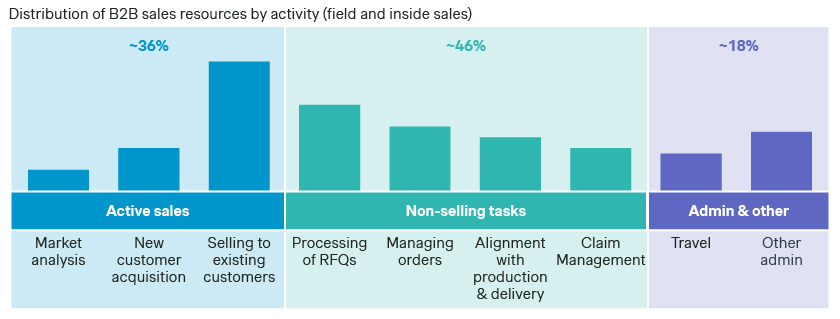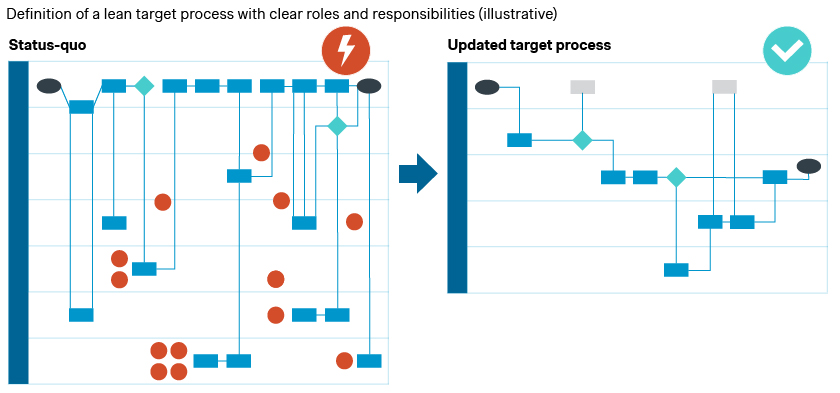Our benchmarks show that B2B sales teams only spend around 36 percent of their time on active sales tasks. We even witness companies that need multiple days to quote for a standard product due to manual processes. This leads to frustrations for sales as well as on the client side. Reducing dead sales time by creating lean and automatable sales processes offers great potential to improve sales efficiency and drive growth. In five steps, you can achieve these goals by creating a digitally enabled B2B sales process that works for you.
Typically, only 36 percent of a B2B sales team's resources are directed towards active sales activities. This includes interactions with clients, nurturing relationships, and executing sales. Meanwhile, an overwhelming 44 percent of the resources are devoted to non-selling tasks, such as processing requests and managing existing orders. An additional 20 percent is absorbed by administrative duties (yes, that includes deciphering travel expense forms).
Essentially, sales teams allocate 64 percent of their time to activities that do not directly foster growth - in other words, dead sales time. This most frequently happens in the lead clarification and quotation steps of the lead-to-cash sales process.
Why digitize sales processes?
Well, the answer is quite simple and yet complex. The simple answer is: because non digital means non automated and therefore inefficient. Despite struggling to attract and retain talent, many companies are simply wasting their resources and capabilities for the wrong tasks. The complex answer is that many companies are operating in complex environments and are confronted with specific customer demands, trends, release changes of ERPs, CRMs, CPQs or even regulations. If the sales process involves manual work, companies simply fail in the long term.
Most companies are already aware of inefficiencies and are exploring strategies to make their sales processes more digital. Yet, only half of these companies are successful.

Why do companies fail in automating sales?
The journey towards transforming sales processes into efficient, digitally enabled operations is fraught with challenges. Most B2B sales processes have evolved organically over the years. However, teams lack efficiency and clarity regarding roles and responsibilities.
Attempts to make these processes more efficient simply by automating and replicating them in systems and tools will fail. Automating an inefficient process simply replicates inefficiencies. To succeed in the digital sphere, a clear and lean target process (including roles and responsibilities) needs to be defined first.
Digital-ready sales processes: Five steps to success
To navigate digital transformation of your B2B sales process successfully, it is imperative to understand the specific business requirements first. The future sales process must then be redesigned to fulfill these requirements.

The following five steps lead to a digital-ready B2B sales process:
1. Analyze current processes and identify pain points.
Thoroughly review existing sales processes to identify value-adding tasks as well as those that do not directly add value but are necessary for the overall functionality of the process. Even though companies are not always comparable, using benchmarks from similar companies can lead to additional insights on “what good looks like” and avoids reinventing the wheel.
2. Define lean target process and clear responsibilities.
Redesign your sales process to eliminate inefficiencies. Clearly assign roles, responsibilities, and task allocation to reduce overlap and redundancies.
3. Validate target process with the ones doing it: your sales team.
Simulate the process with the sales team to gather feedback on its practicality and effectiveness. If and where necessary, fine-tune the process and make sure it works seamlessly in a real-world setting.
4. Formulate a digitalization strategy for the target process.
Identify steps of the process that can be automated through digitalization and define the required tools and infrastructure. Develop a strategic plan for implementing digital tools and technologies that will support and enhance the new sales process.
5. Implement target process to optimally utilize sales time.
Pilot and then gradually roll out the redesigned sales process across the organization. Closely monitor the implementation to ensure a smooth adoption. Make any necessary adjustments to maximize sales time and process efficiency.
Getting your digital-first B2B sales process to sell with Simon-Kucher
Your sales force should sell, not drown in paperwork or non-value creating tasks. By defining a clear target process and successfully incorporating digital tools, you can foster sustainable sales growth.
Our experience shows that 15-20 percent of dead sales time can be freed up just by defining a lean digital-ready target process (this does not include additional savings from sales automation).
At Simon-Kucher, we understand that stability and a strategic sales plan are critical to your organization’s success. Designed with precision, our propriety suite of Elevate solutions aims to uncover opportunities that lead you to profitable digital growth.
Interested in learning how your sales team can utilize their time to achieve increased win rates? Reach out to our experts for an informal discussion and let's get your sales to sell.
Explore all the insights from our B2B Masterclass
Unlock practical strategies in B2B pricing, sales, and marketing



